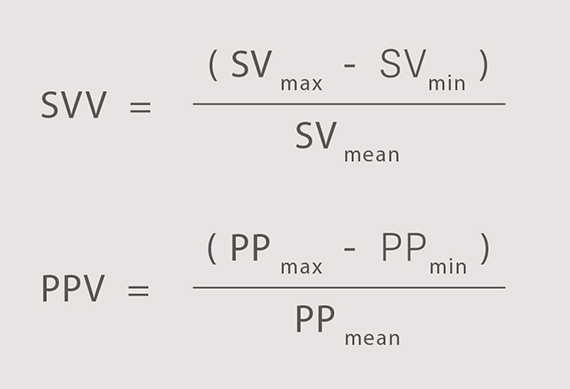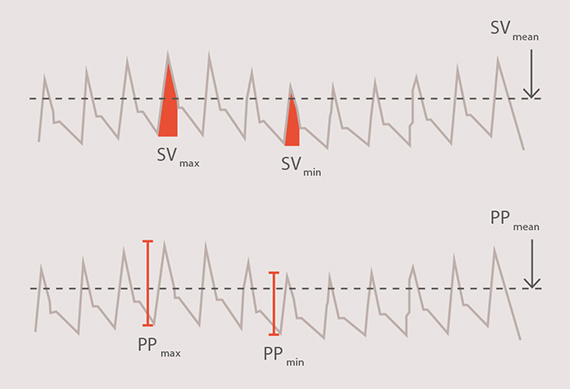Advanced Monitoring Parameters: SVV, PPV
Volume responsiveness -
Stroke Volume Variation (SVV), Pulse Pressure Variation (PPV)
The stroke volume variation (SVV) or pulse pressure variation (PPV) give – provided there is a continuously ventilated patient with a stable heart rhythm – information as to whether an increase in preload will also lead to an increase in stroke volume. Mechanical ventilation induces cyclic changes in vena cava blood flow, pulmonary artery blood flow and aortic blood flow.[1]
At the bedside, changes in the aortic blood flow are reflected by swings in the blood pressure curve (and thus variations in stroke volume and blood pressure). The magnitude of these variations is highly dependent on the volume responsiveness of the patient. With controlled ventilation, the rise in intrathoracic pressure during early inspiration leads to a squeezing of the pulmonary blood into the left ventricle. This process in turn increases the left ventricular preload. With a volume responsive patient, this results in an increased stroke volume or pulse pressure.
Stroke volume variation (SVV) and pulse pressure variation (PPV)
The higher the variation the more likely the patient is to be volume responsive. For proper use of the parameters, the following preconditions must be fulfilled:
- Fully controlled mechanical ventilation with a tidal volume ≥ 8 ml/kg PBW (predicted body weight)
- Sinus rhythm
- Pressure curves free of artifacts


Volume responsiveness
Mechanical ventilation induces cyclic changes in vena cava blood flow, pulmonary artery blood flow and aortic blood flow. At the bedside, changes in the aortic blood flow are reflected by swings in the blood pressure curve (and thus variations in stroke volume and blood pressure). The magnitude of these variations is highly dependent on the volume responsiveness of the patient.
With controlled ventilation, the rise in intrathoracic pressure during early inspiration leads to a squeezing of the pulmonary blood into the left ventricle. This process in turn increases the left ventricular preload. With a volume responsive patient, this results in an increased stroke volume or pulse pressure.
Stroke volume variation (SVV)
Pulse pressure variation (PPV)
